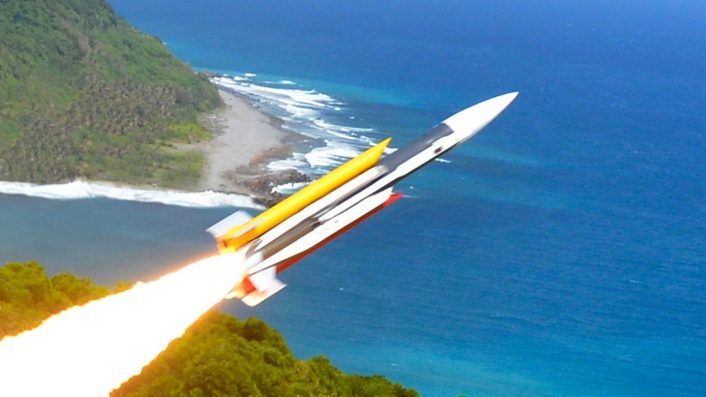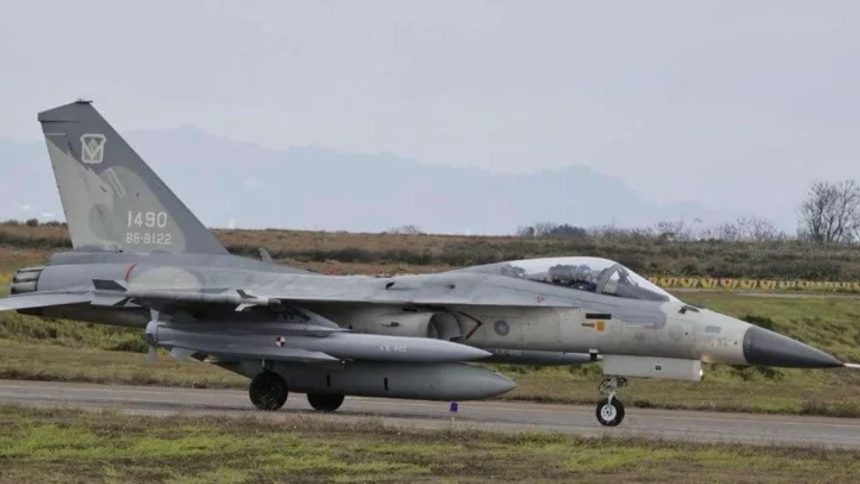The photo of the HF-III on the F-CK-1 follows the reports about the RoCAF and NCSIST working to integrate the anti-ship missile on the indigenous fighter jet, modifying it to make it lighter and more compact.
More than a year after Taiwanese defense and Air Force revealed plans to integrate the HF-III (Hsiung Feng III or HF-3) AShM (Anti-Ship Missile) on its domestically-made F-CK-1 Ching-kuo IDF (Indigenous Defense Fighter), UDN published an image of the missile being carried by the jet.
The picture shows the fighter carrying a missile on each of the wings on the inner hardpoints, and it appears the weapon is a test article, based on its markings. The aircraft is also carrying 275 gallon external fuel tanks on its centerline hardpoint and two inert Sky Sword air-to-air missiles.
The Hsiung Feng II and III missiles are the Republic of China (RoC) Navy’s most advanced and the mainstay of their anti-shipping arsenal. According to UDN, the basic version of the missile can reach a speed of Mach 3.5 and touch ranges between 150 km to 300 km. It has been often hailed as a “carrier killer” owing to its high terminal stage speed that reduces the reaction time of the ship.
🔴 Tayvan’ın Hsiung Feng-3 füzesi küçültülmüş versiyonu ilk kez görüntülendi.
▪️F-CK-1 savaş uçakları tarafından taşınan HF füzesinin hava versiyonu. pic.twitter.com/wxGCy5OQc5
— Kamil Görgülü (@kamilgorgulu1) February 22, 2025
HF-III and IDF compatibility
This new development follows reports from late-2023, which said that the RoCAF (Republic of China Air Force), along with the missile’s developer, NCSIST (National Chung Shan Institute of Science and Technology), was examining whether its homegrown Indigenous Defense Fighter (IDF) F-CK-1 can fire an air-launched version of the HF III AShM to be able to hit PLA Navy vessels from a greater distance, and with higher speed and greater kinematic force.
The IDF entered service in the RoCAF in 1991. Its airframe, powerplant, avionics were developed in cooperation with General Dynamics, Honeywell (then Garrett) and the erstwhile subsidiaries of BAE Systems and Northrop Grumman. While the IDF has been found to possess suitable aerodynamic characteristics and kinematic performance for firing the missile, the missile itself had to be tweaked and modified to be operated by the fighter.
Taiwan News reported in Dec. 2023 that the IDF did possess the required flight speeds with the “initial velocity for launching the missiles.” However, at 1,500 kilograms, the missile is rather heavy. The IDF can carry a maximum payload of 4,000 kg. The need therefore was to reduce the missile’s weight and alleviate structural stress on the IDF’s airframe, which would naturally pose both safety risks and maintenance, logistical issues, relegating the aircraft to the hangar.
The HF-III was originally a land-fired AShM, and the boosters propelled the missile against gravity, adding to its range and striking force. A ramjet engine then takes over to propel the weapon through the rest of its journey. Other Taiwanese reports also said the missile was being upgraded to enhance its “performance radius”.

Modification project
“To alleviate the weight burden, two boosters originally outfitted on the Hsiung Feng III missiles have been removed, and the missile body has been moderately downsized and reduced in weight,” Taiwan News said. The missile now weighs 1,300 kg minus the two boosters.
In the modification project, according to UDN, NCSIST endeavoured to “miniaturize” and make the HF-III “compact”, so that the air-launched version’s length is within 5.5 meters and the diameter is within 36 centimeters. The weapon now weighs around 900 kg.
It is not known if any changes have been made to the warhead, seeker and guidance sections. Being carried and launched by a supersonic fighter provides the initial launch speed and eliminates the need for the booster. “It is estimated that it can enter the combat evaluation stage this year,” UDN added. If successful, the missile can then enter serial production.
As #HanKuang 38th Exercise kicked off today, our airmen with the 1st Tactical Fighter Wing #ROCAF relocated their IDF fighters while local anti-air artillery units watched over the surrounding airspace. We #ROCArmedForces🇹🇼 ensure our capacity in all domains to #protectourcountry pic.twitter.com/080uRziAaO
— 國防部 Ministry of National Defense, ROC(Taiwan) 🇹🇼 (@MoNDefense) July 25, 2022
Tactical use
So far, there have been no reports suggesting plans to integrate the missile with the RoCAF’s F-16 Viper Block 70s or the French-origin Mirage 2000s. That seems unlikely however, since the two fighters are the most advanced in the RoCAF’s fleet and would have more utility against the PLA Navy and PLA Air Force’s J-15, J-16, J-11 and J-10 fighters.
But at the same time, given its small fleet before the huge numbers fielded by the PLA, the RoCAF cannot afford to limit the IDF to just aerial anti-shipping strikes either. It is possible that the jet might be armed with some air-to-air missiles for CAPs (Combat Air Patrols). While flying without the air-launched HF-III, it could be used to provide integral defense to F-16 and Mirage 2000s pairs and perform point defense roles for air bases and military installations.
The IDF would have made some difference to the aerial parity before China had Taipei proceeded with the development of the ADF (Advanced Defense Fighter), which it decided to cancel and focus on “asymmetric” systems like the Chien Hsiang loitering munition, as reported by The Aviationist. A locally developed, new Gen. 5 or 4.5 fighter force multiplies the existing fleet and gives Taiwanese commanders a lot of flexibility and some options, allowing them to hold off an invading PLA, long enough for Allied reinforcements to arrive.
Taiwan develops Hsiung-Feng III as a defence against Chinese aggression.
It wanted to repair a Swiss origin part.
So it was sent to Switzerland.
Switzerland instead sent it to China for work! pic.twitter.com/IIws7EaxSt
— Sankalan Chattopadhyay (@VinodDX9) January 4, 2023
Previous Taiwanese AShM tests
In mid-Sep. 2023, the Republic of China Navy (RoCN) conducted an exercise involving the HF-II, HF-III, and a U.S.-made Harpoon anti-ship missile (AShM), with videos showing them hitting target vessels. Pictures showed three holes punched in the retired warship used for target practice.
Prior to that, in July 2023, Taiwan’s Ministry of National Defense (MND) announced hiking the production of its homegrown AShM platforms, according to Taipei Times, which includes the HF-III, an extended-range variant of the HF-II.









